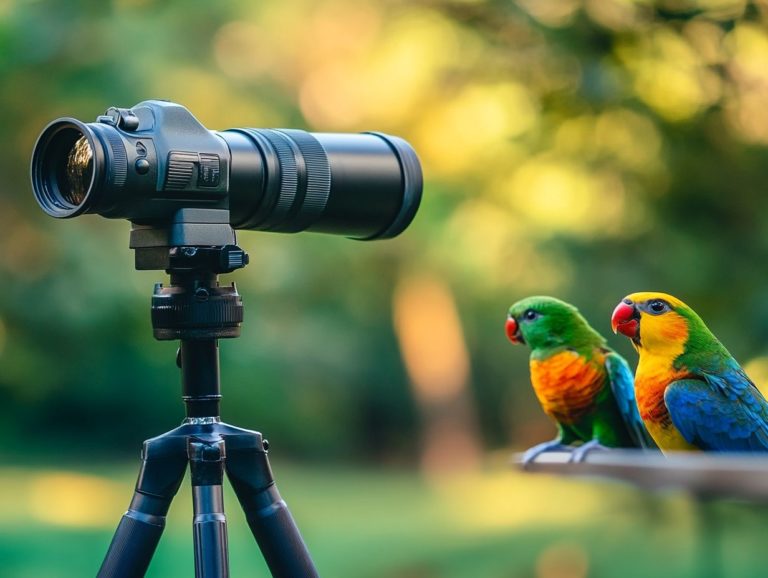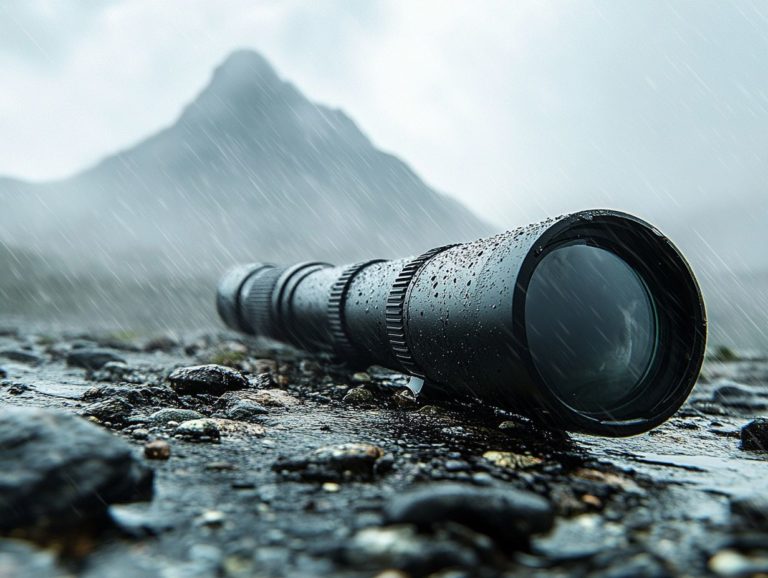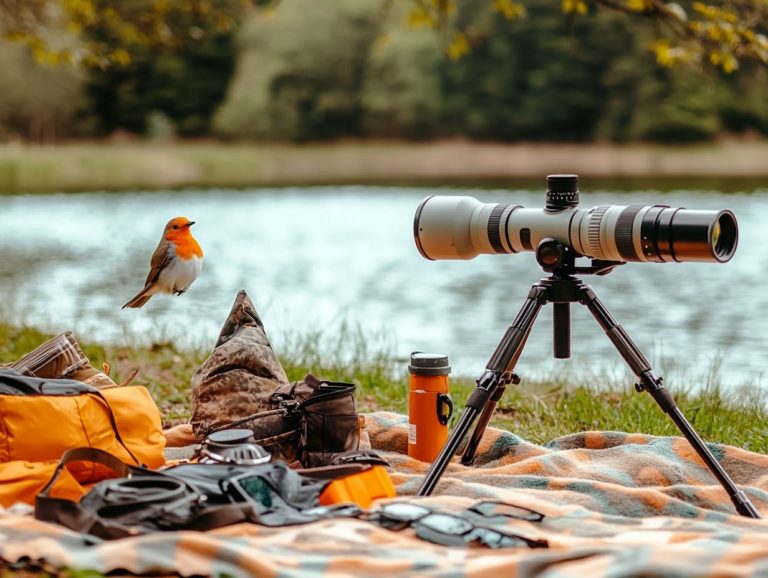Best Practices for Carrying Your Spotting Scope
A spotting scope can enhance your outdoor adventures. It takes activities like birdwatching and hunting to the next level.
This article explores the many benefits of having a spotting scope in your arsenal, ensuring you make the most of every experience in the great outdoors.
You ll learn how to select the perfect spotting scope that aligns with your specific needs, uncover effective carrying techniques, and receive valuable insights on safeguarding your equipment.
By mastering best practices for posture and awareness, you ll be fully prepared to maximize your spotting scope escapades.
Contents
- Key Takeaways:
- Benefits of Carrying a Spotting Scope
- Choosing the Right Spotting Scope for Your Needs
- Proper Carrying Techniques
- Tips for Protecting Your Spotting Scope
- Best Practices for Carrying Your Spotting Scope
- Frequently Asked Questions
- What are the best practices for carrying your spotting scope?
- Why should I use a padded carrying case for my spotting scope?
- Is it important to keep my spotting scope secure while carrying it?
- What is the best way to carry a spotting scope?
- Can I carry my spotting scope by the eyepiece?
- Should I clean my spotting scope before storing it in a carrying case?
Key Takeaways:
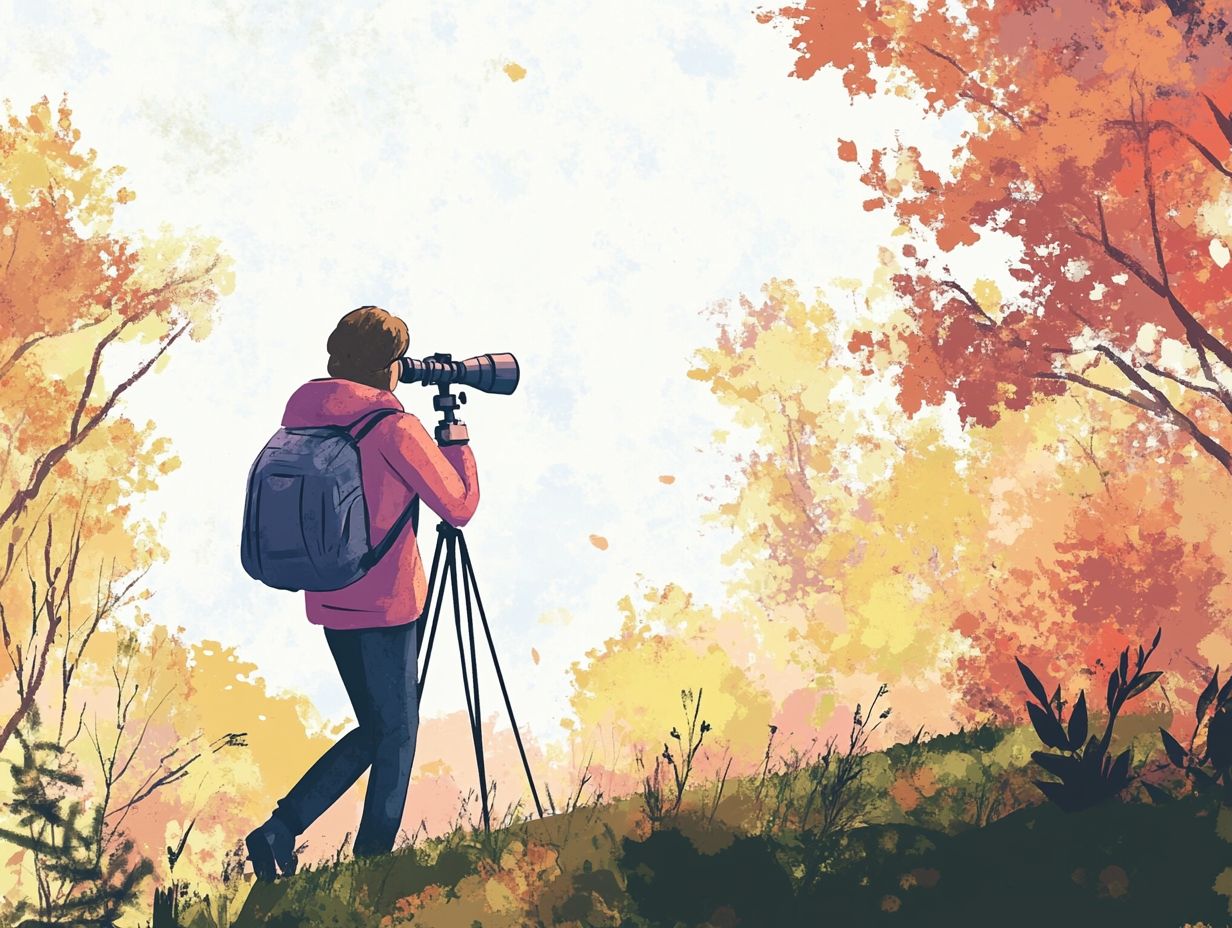
- Properly carrying your spotting scope can enhance your outdoor experiences and help you get the most out of your adventures.
- When choosing a spotting scope, consider factors such as magnification, size, and weight to ensure it meets your specific needs.
- Using a tripod or harness can help you carry your spotting scope with ease and protect it from damage or wear and tear.
What is a Spotting Scope?
A spotting scope is your go-to high-powered device for detailed observation, whether you re indulging in birdwatching or diving into wildlife exploration. With features like varying magnification ranges, top-notch objective lenses, and superior lens coatings, these scopes deliver a crystal-clear, magnified view of your distant subjects. They stand out as an exceptional alternative to traditional binoculars or monoculars, allowing you to immerse yourself in the beauty of nature with stunning detail and clarity.
These scopes typically house an optical tube with advanced glass optics that optimize light transmission while minimizing distortion. The lens quality often outshines that of binoculars or monoculars, ensuring you can spot intricate details think feather arrangements or the subtle movements of wildlife that might otherwise go unnoticed.
While binoculars provide a wider field of view for quick scanning, spotting scopes truly shine when it comes to bringing distant subjects into sharp focus, a crucial advantage during nature observation. Plus, the ability to use a camera with the spotting scope makes these devices a favorite among enthusiasts eager to capture their outdoor experiences in stunning detail.
Benefits of Carrying a Spotting Scope
Carrying a spotting scope presents a wealth of advantages for outdoor enthusiasts, especially those engaged in birdwatching, wildlife observation, and choosing a lightweight spotting scope for travel.
Its capability to deliver a high magnification range allows you to observe wildlife with remarkable detail, transforming it into an essential tool for anyone who cherishes nature. Quality spotting scopes provide clarity that elevates your outdoor experience. You ll appreciate nature s details in new ways.
Enhancing Outdoor Experiences
A spotting scope elevates your outdoor adventures, providing exceptional clarity and detail as you observe wildlife and nature. It allows you to engage with your surroundings in ways you may have thought impossible. The thrill of achieving close-up views from a distance adds an exhilarating layer of wonder to each excursion.
Many spotting scope users have discovered that a spotting scope unveils new opportunities for exploration, revealing intricate feather patterns as a bird flits between branches or capturing the subtle movements of elusive creatures that typically remain hidden.
Beyond simply enhancing visual quality, this remarkable tool cultivates a deeper connection with nature. You can truly marvel at the vibrant colors and fascinating behaviors of wildlife. With its easy portability, it fits seamlessly into your adventures, giving you the power to experience the great outdoors in a more profound and intimate way.
Choosing the Right Spotting Scope for Your Needs
Selecting the perfect spotting scope requires a thoughtful evaluation of several key features tailored to your unique needs, whether you re engaged in birdwatching, hunting, or wildlife observation.
Crucial factors such as magnification range, objective lens size, and lens quality significantly influence the scope’s performance, directly impacting your viewing experience.
By making an informed purchase, you ll set yourself up for long-term satisfaction and enjoyment in your outdoor adventures.
Factors to Consider
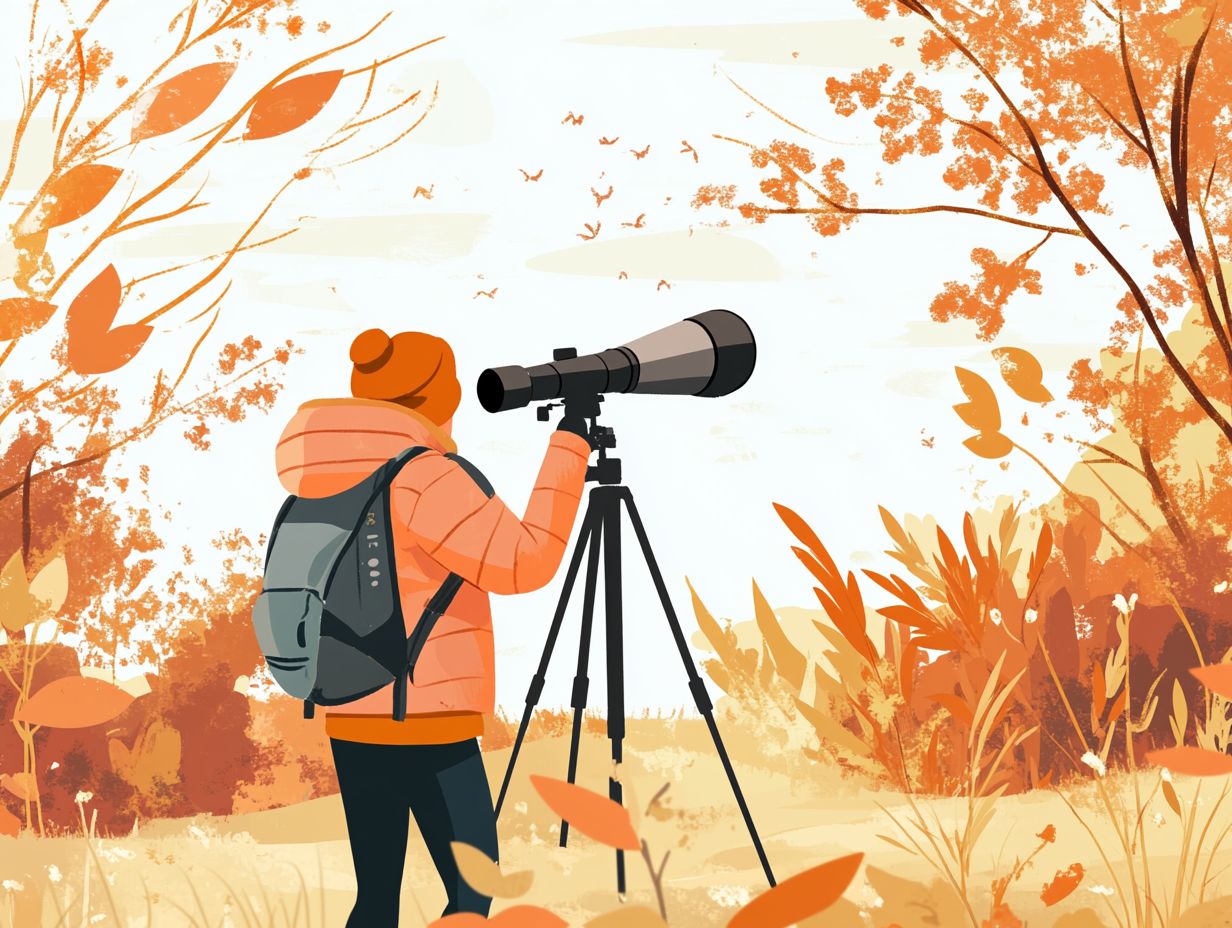
When you re on the hunt for the perfect spotting scope, several factors warrant your attention. This ensures it meets your unique needs and preferences. Key features like magnification range, objective lens size, and lens quality will directly influence the clarity of your observations.
Prioritizing waterproofing and tripod stability is essential for optimal performance in varying atmospheric conditions. This enhancement will elevate your outdoor experiences.
The type of prism system the way the scope refracts light plays a significant role in the scope’s compactness and weight. This is crucial for portability during those long hikes or excursions. Additionally, an adjustable eyecup is vital for comfortable extended viewing sessions, especially if you wear glasses.
Don t miss out on the amazing value that quality optics can bring to your adventures! Investing in a good price-to-performance ratio can significantly elevate the level of detail you capture. This connection with nature becomes all the more profound, whether you re birdwatching, hunting, or indulging in a bit of stargazing.
Proper Carrying Techniques
Mastering proper carrying techniques is crucial for the safe transport and longevity of your spotting scope. For more insights, check out spotting scope etiquette, especially during those cherished extended outdoor adventures.
By utilizing a quality spotting scope case, you can shield your equipment from environmental factors that might compromise its performance. Additionally, field testing your spotting scope helps you understand how to distribute weight effectively, enhancing your carrying stability.
These techniques not only protect your investment but also elevate your overall outdoor experience. This makes it more comfortable and efficient, especially when using a harness or strap.
Using a Tripod or Monopod
Utilizing a tripod or monopod is essential for achieving the stability you crave when using a spotting scope. This ensures your observations remain clear and steady. A tripod provides the ultimate support, allowing you to adjust the focus knob effortlessly without the distraction of hand movement.
On the other hand, a monopod offers the flexibility you need when you’re on the move. Selecting the right support system can dramatically enhance your outdoor optics experience.
In environments where light conditions fluctuate, like during dawn or dusk, the stability of a tripod becomes increasingly beneficial. It minimizes vibrations and allows for prolonged viewing without the fatigue that often accompanies hand-holding.
The added sturdiness of a tripod means finer details like the intricate plumage of a bird or the subtle nuances of distant landscapes become much more discernible. Meanwhile, a monopod shines in quick setups and mobility, making it a fantastic choice for wildlife viewing while hiking. It provides a stable platform for close-up viewing.
Ultimately, your decision between these two stabilizing tools should reflect your specific needs as an observer. Both options significantly contribute to the quality of your viewing experience, so choose wisely.
Using a Harness or Strap
Using a harness or strap to carry your spotting scope can dramatically enhance your comfort and convenience during those long outdoor adventures. For the best experience, consider the top 10 accessories for your spotting scope, as these accessories work wonders by distributing weight evenly across your body, which helps reduce strain and fatigue.
This allows you to keep your equipment easily accessible. By alleviating pressure on your back and shoulders, you ll be able to enjoy longer observation sessions without the nagging discomfort.
This is particularly vital for passionate birdwatchers or wildlife enthusiasts who frequently traverse varied terrains. The added security of a harness ensures that your spotting scope remains securely in place, minimizing the risk of drops or damage as you navigate the trails.
These game-changing outdoor solutions give you the ultimate hands-free experience! They allow for hands-free mobility, giving you the freedom to engage with your surroundings, capture unforgettable moments, and truly immerse yourself in nature without the cumbersome hassle of traditional carrying methods while using your spotting scope.
Tips for Protecting Your Spotting Scope
Protecting your spotting scope is crucial for ensuring its performance and longevity. This is especially important when you’re faced with unpredictable weather and outdoor adventures.
Weatherproofing features, such as durable lens coatings and sturdy casings, shield your equipment from rain, dust, and various environmental elements. These features help ensure your spotting scope remains in top condition.
By committing to regular maintenance and storing your spotting scope properly in a dedicated case, you can significantly enhance its protection. For detailed guidance, refer to spotting scope maintenance, which allows you to relish those crystal-clear views for years to come.
Weatherproofing and Maintenance
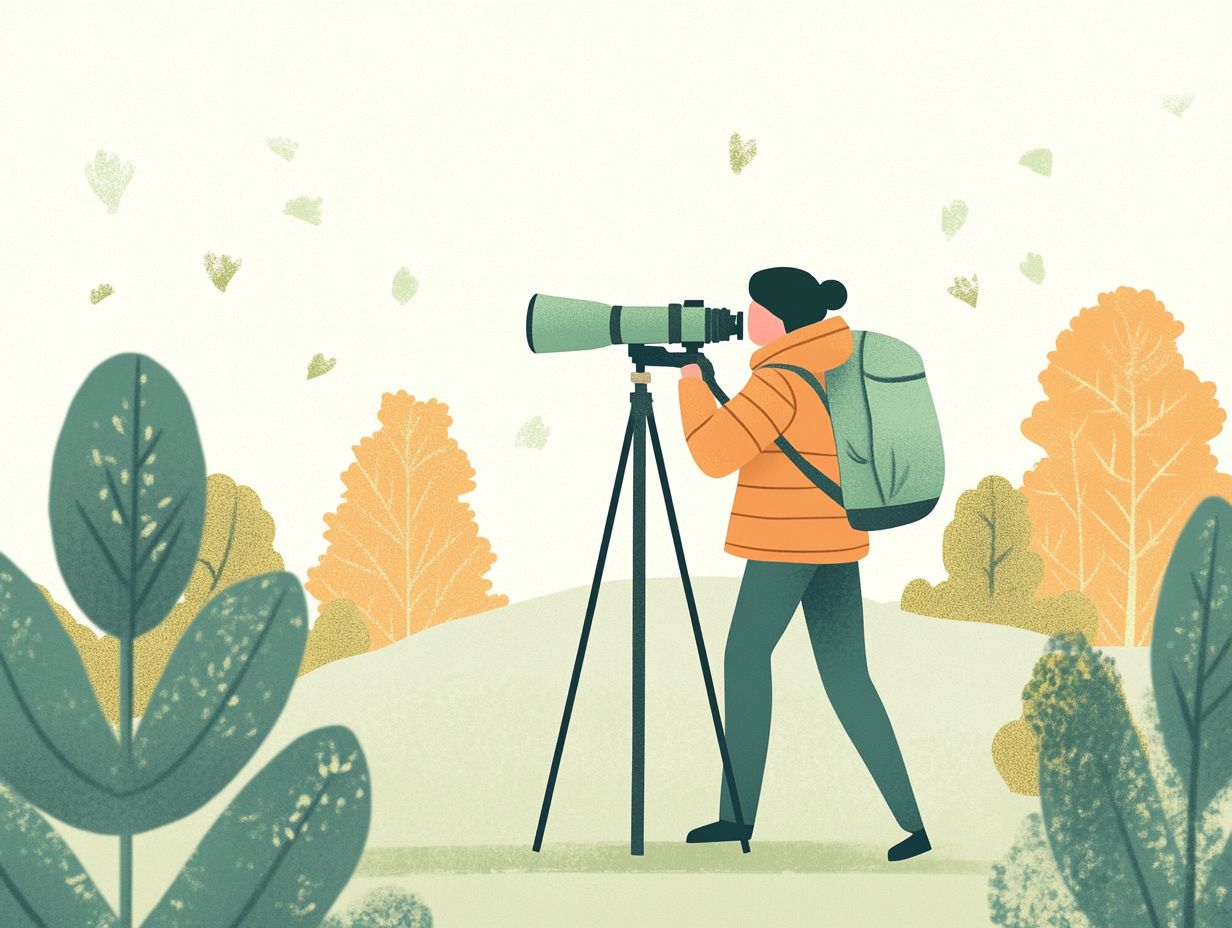
Weatherproofing and regular maintenance are essential for the longevity and optimal performance of your spotting scope. Investing in waterproof features will shield your equipment from moisture damage.
Additionally, regularly cleaning the lens will keep your views crystal clear. By prioritizing these elements of spotting scope protection, you can significantly extend the lifespan and effectiveness of your outdoor optics.
Opting for scopes that are fog-proof designed to prevent fogging on the lens and fully sealed designs will further enhance their resilience against harsh conditions. This allows you to confidently explore various terrains.
Regularly inspect for signs of wear or damage, along with thorough cleanings using a proper lens brush and microfiber cloth. This practice will elevate your viewing experiences.
It’s crucial to familiarize yourself with the specific maintenance needs of your spotting scope, whether you’re birdwatching, hunting, or stargazing. This knowledge ensures these high-performing optical tools remain in peak condition.
A little care truly goes a long way in preserving the enjoyment you get from your outdoor optics. Don’t wait until it’s too late protect your scope now!
Best Practices for Carrying Your Spotting Scope
Implementing best practices for carrying your spotting scope can significantly elevate your experience during outdoor activities. Additionally, learning how to store your spotting scope safely ensures both comfort and stability.
Proper positioning and weight distribution are crucial in minimizing fatigue. This allows you to fully enjoy your excursions while observing wildlife.
Proper Posture and Weight Distribution
Maintaining proper posture and weight distribution while carrying your spotting scope is essential for comfort. To protect your investment, consider spotting scope care techniques that minimize strain during your outdoor adventures.
By ensuring that the weight of your equipment is evenly distributed, you can prevent fatigue and elevate your overall experience while observing wildlife.
To achieve this, adopt a balanced stance with your feet shoulder-width apart for greater stability. Utilizing a padded strap significantly reduces pressure on your shoulders and neck, further easing discomfort.
Keeping the spotting scope close to your body as you walk minimizes leverage on your back, granting you better control over your movements. For a more comprehensive approach, consider following this step-by-step guide for setting up your spotting scope. Remember to take breaks to stretch and readjust your posture; this simple practice can markedly enhance your comfort and enjoyment in the great outdoors.
Start following these tips today for the best outdoor experiences!
Being Aware of Your Surroundings
Being aware of your surroundings is crucial for spotting scope users. This awareness enhances both your safety and the quality of your wildlife observation.
It keeps you alert to potential hazards and provides opportunities for observing wildlife up close. By practicing mindfulness and situational awareness, you can maximize your outdoor experiences.
Familiarizing yourself with the environment is key. It helps you identify other people nearby and the behaviors of local wildlife.
Recognizing signs of animal activity like tracks or sounds can lead to delightful encounters with nature. Staying aware can also help you avoid mishaps, such as tripping over uneven terrain.
When using a spotting scope, frequently check your surroundings. This simple habit ensures a safer and more rewarding wildlife observation experience.
Being proactive and maintaining vigilance deepens your connection to wildlife and prioritizes your safety.
Frequently Asked Questions
What are the best practices for carrying your spotting scope?
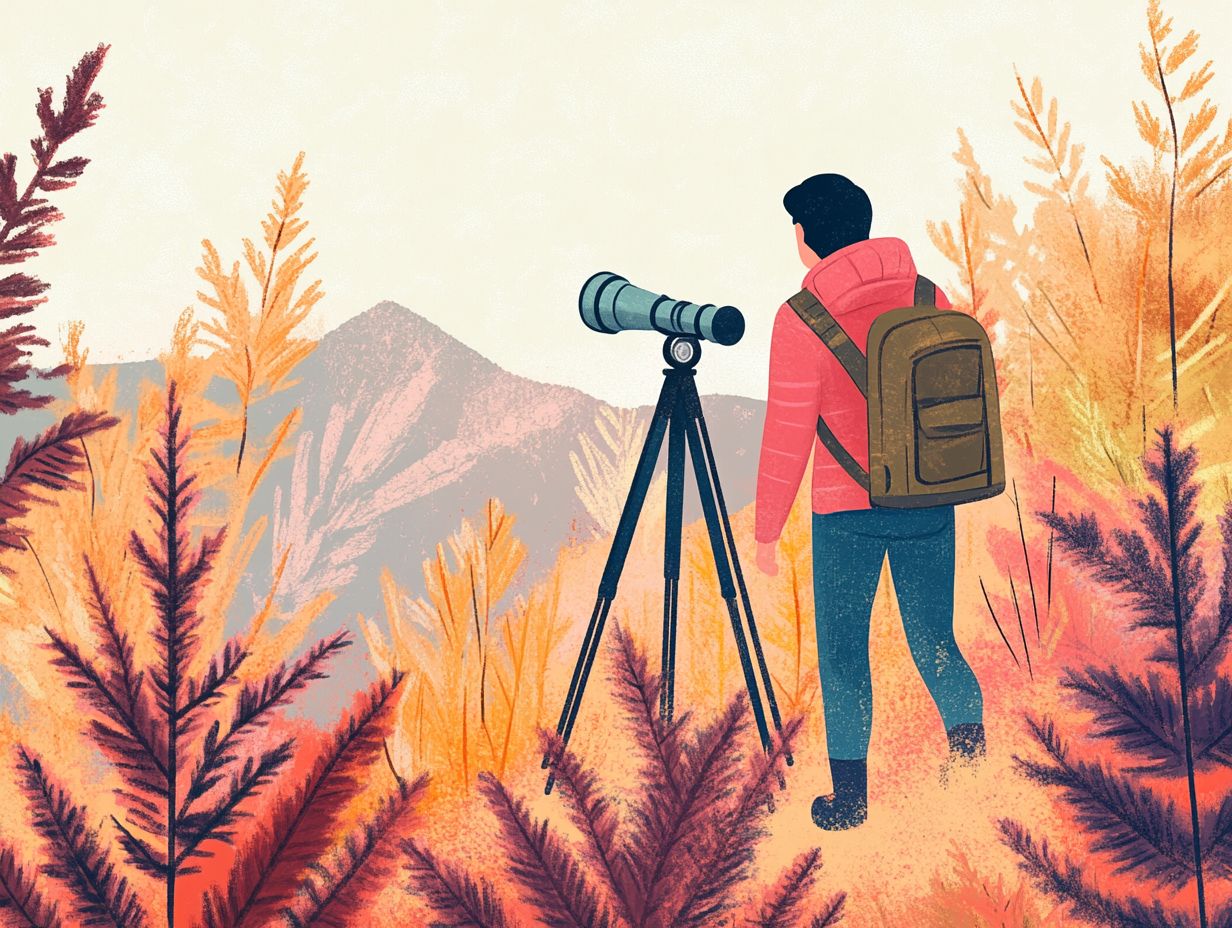
Use a padded carrying case and secure it with straps or a harness. Avoid carrying it by the eyepiece to protect its integrity.
Why should I use a padded carrying case for my spotting scope?
A padded carrying case protects your spotting scope from bumps, drops, moisture, and dust. It also makes carrying it comfortable for longer periods.
Is it important to keep my spotting scope secure while carrying it?
Yes, using straps or a harness keeps your spotting scope secure while carrying it. This prevents shifting or falling, which could damage the scope or other equipment.
What is the best way to carry a spotting scope?
The best way to carry a spotting scope is by using a carrying case with a shoulder strap or a harness specifically designed for spotting scopes. This distributes the weight evenly and keeps your hands free for other tasks, allowing you to focus on making the most of your spotting scope setup.
Can I carry my spotting scope by the eyepiece?
No, it is not recommended to carry your spotting scope by the eyepiece. This can damage delicate internal components and cause misalignment, affecting the scope’s performance.
Should I clean my spotting scope before storing it in a carrying case?
Yes, cleaning your spotting scope before storing it in a carrying case is important. This prevents dirt and debris from accumulating and potentially causing damage to the scope or other equipment.

